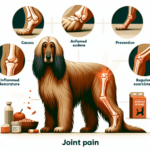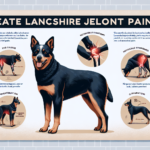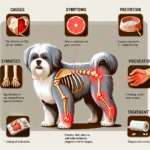Norfolk Terrier Joint Pain: Causes, Symptoms, Prevention, and Treatment

Introduction
The Norfolk Terrier is a small, spirited breed known for its friendly demeanor and tenacious nature. Originating from England, this breed was initially developed for hunting small vermin. Norfolk Terriers are characterized by their wiry coat, expressive eyes, and distinctive folded ears. Despite their small size, they are robust and energetic, making them excellent companions for active families.
Like many breeds, Norfolk Terriers are prone to certain health issues. Common concerns include dental problems, heart conditions, and joint pain. Joint health is particularly crucial for this breed due to their active lifestyle and genetic predispositions.
Maintaining joint health in Norfolk Terriers is essential to ensure they lead a comfortable and active life. Joint pain can significantly impact their quality of life, making it vital for owners to understand the causes, symptoms, prevention, and treatment options available.
Breed-Specific Joint Pain Risks
Genetic Predisposition
Norfolk Terriers, like many small breeds, can be genetically predisposed to joint-related issues. Conditions such as hip dysplasia, arthritis, and elbow dysplasia are not uncommon. Hip dysplasia, in particular, is a hereditary condition where the hip joint does not fit properly into the hip socket, leading to pain and mobility issues. Arthritis, a degenerative joint disease, can also develop as the dog ages, causing inflammation and discomfort.
Age-Related Risks
As Norfolk Terriers age, the risk of developing joint pain increases. Typically, signs of joint issues may start to appear in middle age, around 5-7 years old. However, this can vary depending on the individual dog’s genetics and lifestyle. Senior Norfolk Terriers, those over 10 years old, are particularly susceptible to arthritis and other degenerative joint conditions.
Activity Level and Joint Stress
Norfolk Terriers are known for their high energy levels and love for physical activities. Whether it’s chasing a ball, going for long walks, or participating in agility training, their active lifestyle can put significant stress on their joints. While regular exercise is essential for their overall health, excessive or high-impact activities can exacerbate joint issues, especially if the dog is genetically predisposed to such conditions.
Common Symptoms of Joint Pain in Norfolk Terriers
General Symptoms
Owners should be vigilant for common symptoms of joint pain in their Norfolk Terrier. These symptoms include:
- Limping: A noticeable limp or favoring one leg over another.
- Stiffness: Difficulty in getting up or lying down, especially after rest.
- Reluctance to Move: Hesitation or refusal to jump, climb stairs, or engage in physical activities.
- Swelling: Visible swelling around the joints.
- Behavioral Changes: Increased irritability or signs of discomfort when touched.
Breed-Specific Symptoms
In Norfolk Terriers, joint pain may manifest in specific ways due to their size and build. Owners might notice a more pronounced limp in the hind legs, difficulty in maintaining their usual energetic behavior, or a reluctance to engage in activities they previously enjoyed. Given their small size, even minor changes in movement or behavior can be significant indicators of joint pain.
When to Consult a Vet
If any of the above symptoms are observed, it is crucial to consult a veterinarian promptly. Early diagnosis and intervention can prevent the progression of joint issues and improve the dog’s quality of life. Regular veterinary check-ups are also essential for monitoring joint health, especially as the dog ages.
Preventive Measures for Joint Health
Exercise Recommendations
Maintaining an appropriate exercise routine is vital for the joint health of Norfolk Terriers. Low-impact activities such as walking, swimming, and gentle play are ideal. These exercises help keep the joints flexible without causing excessive stress. Avoid high-impact activities like jumping or running on hard surfaces, which can exacerbate joint issues.
Dietary Suggestions
A balanced diet rich in essential nutrients can support joint health. Consider incorporating foods or supplements that contain:
- Glucosamine and Chondroitin: These supplements help maintain cartilage health and reduce inflammation.
- Omega-3 Fatty Acids: Found in fish oil, these fatty acids have anti-inflammatory properties that can benefit joint health.
- Antioxidants: Vitamins C and E can help reduce oxidative stress and support overall joint health.
Weight Management
Maintaining a healthy weight is crucial for reducing joint stress. Excess weight can put additional pressure on the joints, exacerbating pain and discomfort. Regularly monitor your Norfolk Terrier’s weight and adjust their diet and exercise routine as needed to ensure they remain within a healthy weight range.
Early Screening and Monitoring
Early screening for joint issues can help catch problems before they become severe. Regular veterinary check-ups should include joint assessments, especially for middle-aged and senior dogs. Genetic testing can also identify predispositions to conditions like hip dysplasia, allowing for proactive management.
Treatment Options for Joint Pain
Non-Surgical Treatments
For many Norfolk Terriers, non-surgical treatments can effectively manage joint pain. These options include:
- Medications: Non-steroidal anti-inflammatory drugs (NSAIDs) can reduce inflammation and pain. Always consult a vet before administering any medication.
- Physical Therapy: Specialized exercises and therapies can improve joint mobility and reduce pain.
- Lifestyle Adjustments: Modifying the dog’s activity level and environment to reduce joint stress.
Surgical Options
In severe cases, surgical intervention may be necessary. Common surgical options include:
- Joint Replacement: Replacing the damaged joint with an artificial one, commonly performed for hip dysplasia.
- Arthroscopy: A minimally invasive procedure to clean out the joint and remove damaged tissue.
- Osteotomy: Cutting and realigning bones to improve joint function.
Alternative Therapies
Alternative therapies can complement traditional treatments and provide additional relief. These include:
- Acupuncture: Can help reduce pain and improve joint function.
- Hydrotherapy: Water-based exercises that reduce joint stress while improving mobility.
- Massage: Helps improve circulation and reduce muscle tension around the joints.
Lifestyle and Management Tips
Daily Care Routine
A consistent daily care routine can help manage joint pain in Norfolk Terriers. This routine might include:
- Gentle morning walks to keep joints flexible.
- Administering any prescribed medications or supplements.
- Engaging in low-impact play sessions.
- Providing a comfortable resting area with an orthopedic bed.
Modifying the Home Environment
Making the home environment more joint-friendly can significantly improve the dog’s comfort. Consider the following modifications:
- Installing ramps to help the dog access furniture or climb stairs.
- Using non-slip mats to prevent falls on slippery surfaces.
- Providing an orthopedic bed to support the joints during rest.
Long-Term Management
Long-term management of joint pain involves regular monitoring and adjustments to the dog’s care routine. This includes:
- Regular veterinary check-ups to monitor joint health.
- Adjusting exercise routines as needed to prevent overexertion.
- Continuing with any prescribed medications or supplements.
- Maintaining a healthy weight through diet and exercise.
FAQs About Norfolk Terriers and Joint Pain
What are the early signs of joint pain in Norfolk Terriers?
Early signs include limping, stiffness, reluctance to move, and behavioral changes such as increased irritability.
Can joint pain in Norfolk Terriers be prevented?
While genetic predispositions cannot be entirely prevented, maintaining a healthy weight, providing a balanced diet, and ensuring appropriate exercise can significantly reduce the risk of joint pain.
Are there specific exercises that are better for Norfolk Terriers with joint pain?
Low-impact exercises such as walking and swimming are ideal for Norfolk Terriers with joint pain. Avoid high-impact activities that can stress the joints.
What dietary supplements can help with joint health in Norfolk Terriers?
Supplements containing glucosamine, chondroitin, and omega-3 fatty acids can support joint health and reduce inflammation.
When should I consult a vet about my Norfolk Terrier’s joint pain?
If you notice any signs of joint pain, such as limping, stiffness, or reluctance to move, consult a veterinarian promptly for a thorough assessment and appropriate treatment plan.
Conclusion
Joint pain is a significant concern for Norfolk Terriers, but with proper care and attention, it can be managed effectively. Understanding the causes, symptoms, preventive measures, and treatment options is crucial for ensuring your Norfolk Terrier leads a happy and active life. Regular veterinary check-ups, a balanced diet, appropriate exercise, and a supportive home environment are key to maintaining your dog’s joint health. By taking proactive steps, you can help your Norfolk Terrier enjoy a comfortable and fulfilling life.




